Emergency
Ethiopia
- 6.8 million
- people earmarked for WFP support in 2025
- 2.6 million
- people could be left without life-saving assistance unless urgent funding is provided
- US$230 million
- needed for life-saving assistance up to March 2026
Food insecurity and malnutrition are at alarming levels in Ethiopia, where widespread displacement, insecurity, drought risks and soaring food prices are fuelling a deepening crisis.
Malnutrition is above the emergency threshold nationwide, with 4.4 million women and young children urgently needing treatment.
Regional conflicts are compounding the crisis, as new refugees arrive with urgent food needs. In total, Ethiopia hosts over 1 million refugees, mainly from South Sudan, Somalia, Eritrea and Sudan.
Insecurity in Amhara poses direct risks to WFP and partners, and is driving up operating costs.
The World Food Programme (WFP) provides food and nutrition assistance, with a plan to support 6.8 million people in 2025.
However, our ability to respond to hunger needs is being severely hampered by critical funding shortfalls. Without urgent funding, 2.6 million of Ethiopia’s most vulnerable people could be cut from life-saving assistance.
WFP is expected to receive just over half of last year’s funding and urgently requires US$230 million to continue life-saving assistance through to March 2026.
What the World Food Programme is doing to respond to the Ethiopia emergency
-
Emergency response
-
WFP plans to support 1.9 million vulnerable Ethiopians and 1 million refugees with emergency food aid. This includes assistance to 650,000 displaced and vulnerable people in Somali Region, and 50,000 South Sudanese refugees in Gambella.
-
Resilience
-
School meals

